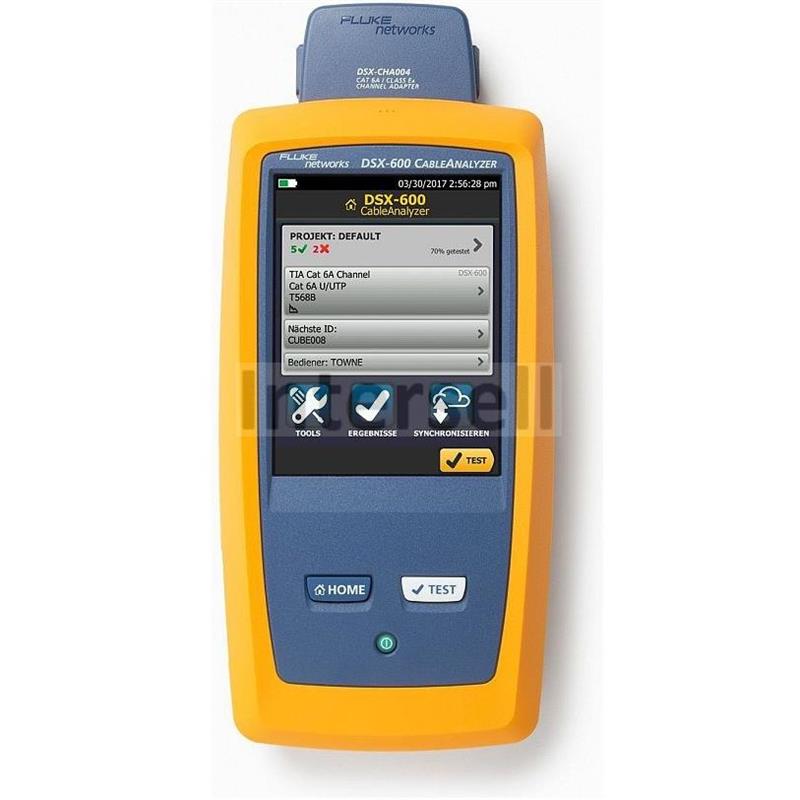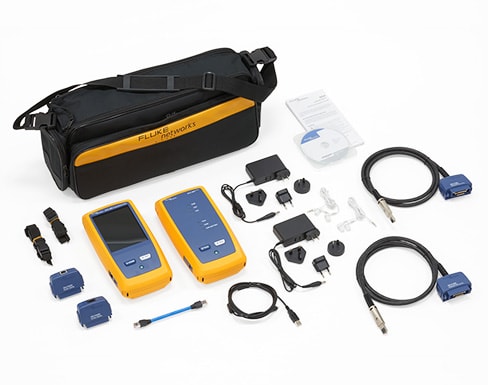




The Fluke Networks DSX-600-PRO Cable Analyzer is a tool used in the necessary cabling certification process. Suitable for structured cabling, incl. twisted pairs from category 3 / class C to category 6A / class EA.
The device has been designed with the comfort of a specialist in mind. Its speed, reliability and the ability to see the results at the end increase your work efficiency. The user interface - based on gestures - is designed so that the operator spends less time interpreting what the device displays and more time testing.
The analyzer has a frequency range of 500MHz, which enables certification of Cat. 6A / Class EA cabling for 10 Gigabit Ethernet in 10 seconds.
An advanced diagnostics system indicates the point of failure and suggests corrective action, while the cloud-based LinkWare ™ Live service allows you to manage certification work anytime, anywhere with any person and device.
Features:
Category 6A certification in 10 seconds
The DSX-600-PRO analyzer offers a complete solution that streamlines every aspect of the certification process - from configuration, through testing and troubleshooting, to reporting the results to the customer. The device performs Class E / Cat 6 certification tests in 9 seconds and Class EA / Cat 6A tests in 10 seconds, while maintaining the highest accuracy and complete compliance with industry standards. This incredible speed allows the operator to test hundreds of connections during an eight-hour shift.
Fast troubleshooting
In the event of a link failure, the HDTDR and HDTDX algorithms provide quick and easy-to-understand clues to identify the point of failure (indicating the distance from the tester). Instead of spending a lot of time trying to correct errors and then re-checking to see if the problem is resolved, the technician knows exactly where to look for damage on the link.
Even if only two percent of certified cables fail the Autotest over the entire shift, the operator still saves over two hours a day for certification.
Fast, even when not tested
The DSX-600-PRO is not only a way to quickly test. The ProjX ™ System manages tasks and progress from setup to system acceptance, ensuring that all tests are performed correctly "first time". The gesture-based Taptive ™ user interface, bright color display, large memory, and built-in talk function contribute to overall productivity while improving user experience. Extended battery life means you can do more with a single charge. All this allows you to save time and money every day.
| Technical parameters | |
| Model | DSX-600-PRO |
| Self-test speed | Full two-way self-test Cat 5e or 6 / Class D or E: 9 seconds Full Two-way Cat 6A / Class EA Self-Test: 10 seconds |
| Test parameters supported (the test standard defines the parameters and the given frequency range) | Wire Map, Length, Propagation Delay, Delay Skew, DC loop resistance, Insertion Loss - attenuation, Return Loss - RL, NEXT (Near-End Crosstalk), Attenuation-to-Crosstalk Ratio (ACR-N), ACR-F (ELFEXT), Power Sum ACR-F (PS ELFEXT), Power Sum NEXT, Power Sum ACR-N, |
| Maximum frequency [MHz] | 500 |
| Cable types | Shielded and Unshielded LAN Cabling: TIA categories 3, 4, 5, 5e, 6, 6A: 100? ISO / IEC Class C, D, E, EA: 100? and 120? |
| Standard coupler adapters | Fixed link adapters Plug type: shielded RJ45 |
| Test standards | |
| TIA | Categories 3, 5, 5e, 6, 6A for TIA 568-C.2 or TIA-1005 |
| ISO / IEC | Classes C and D, E, EA certified to ISO / IEC 11801: 2002 as amended |
| IEEE 802.3 | 10BASE-T 100BASE-TX 1000BASE-T 10GBASE-T |
| General parameters | |
| Dimensions [mm] | 66.7 x 133.3 x 279.4 (2.625 x 5.25 x 11 inches) |
| Weight [kg] | 1.36 (3 lbs) |
| Display | 5.7 inch LCD display with capacitive touch screen (Projected Capacitance) |
| Power | 7.2V lithium ion battery |
| Working time [h] | 8 (typical) |
| Memory | 12,000 Cat 6A results with graphs |
| Working conditions | Ambient temperature: 0 to 45 [° C] Relative humidity: 0 - 90% (at 0 to 35 ° C) 0-70% (at 35 to 45 ° C) |
| The storage conditions | Ambient temperature: -30 to 60 [° C] Relative humidity: 0 - 95% |
| Additional environmental requirements | Vibration: random, 2g, 5-500Hz Drop: up to 1m (resistance test without attached module and adapter) Altitude: 3200m (with AC adapter) / 4000m Safety: CSA 22.2 No. 61010, IEC 61010-1 3rd Edition EMC: EN 61326-1: Portable |

Responsible person
Informacje o bezpieczeństwie
1. Zasilanie (dotyczy produktu zasilanego energią elektryczną)
Urządzenie może być zasilane zarówno z sieci elektrycznej, jak i z wbudowanego akumulatora (jeżeli dotyczy urządzęń z akumulatorem).
Podczas pracy z zasilaniem sieciowym należy stosować wyłącznie oryginalny zasilacz i przewód zasilający dostarczony przez producenta.
Nie wolno używać urządzenia w środowisku wilgotnym ani w pobliżu źródeł ognia.
W przypadku uszkodzenia przewodu zasilającego lub widocznych śladów uszkodzeń obudowy należy natychmiast odłączyć urządzenie od sieci i zaprzestać jego użytkowania.
Akumulator należy ładować wyłącznie przy użyciu dedykowanej ładowarki. Nie należy podejmować prób otwierania, rozbierania ani wymiany akumulatora na własną rękę.
2. Promieniowanie laserowe (dotyczy urządzeń z wbudowanym nadajnikiem laserowym)
Urządzenie zawiera źródło laserowe. Promień lasera jest niewidoczny dla ludzkiego oka, ale może być niebezpieczny.
Nigdy nie należy patrzeć bezpośrednio w zakończenia światłowodu ani do wnętrza portów optycznych, gdy urządzenie jest włączone.
Nie wolno kierować promienia lasera w stronę oczu ludzi ani zwierząt.
Prace instalacyjne i serwisowe powinny być wykonywane wyłącznie przez osoby posiadające odpowiednie przeszkolenie z zakresu bezpieczeństwa pracy z laserami.
Oznaczenia bezpieczeństwa i etykiety ostrzegawcze umieszczone na urządzeniu nie mogą być usuwane ani zasłaniane.
3. Bezpieczeństwo przy pracy ze światłowodami
Odcinki i resztki włókien światłowodowych mogą być bardzo ostre – istnieje ryzyko zranienia skóry oraz wniknięcia w tkanki.
Wszelkie prace związane z cięciem, obróbką czy usuwaniem włókien powinny być wykonywane w rękawicach ochronnych i na odpowiedniej powierzchni roboczej.
Odpady światłowodowe należy gromadzić w zamkniętych pojemnikach i utylizować zgodnie z zaleceniami BHP.
4. Ogólne zasady bezpieczeństwa
Przed rozpoczęciem pracy należy zapoznać się z całą instrukcją obsługi i przestrzegać zaleceń producenta.
Urządzenie powinno być używane wyłącznie zgodnie z jego przeznaczeniem – do pracy z sieciami światłowodowymi.
Nie należy ingerować w konstrukcję urządzenia ani dokonywać samodzielnych napraw.
W przypadku zauważenia nietypowego zapachu, dymu, przegrzewania się lub nieprawidłowego działania, należy niezwłocznie odłączyć urządzenie od zasilania i skontaktować się z serwisem.
Urządzenie oraz wszelkie elementy światłowodowe muszą być zawsze przechowywane i użytkowane z dala od dzieci.